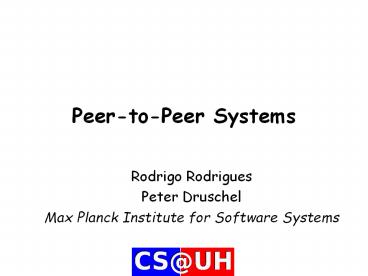Peer-to-Peer Systems - PowerPoint PPT Presentation
Title:
Peer-to-Peer Systems
Description:
Peer-to-Peer Systems Rodrigo Rodrigues Peter Druschel Max Planck Institute for Software Systems ... – PowerPoint PPT presentation
Number of Views:279
Avg rating:3.0/5.0
Title: Peer-to-Peer Systems
1
Peer-to-Peer Systems
- Rodrigo Rodrigues
- Peter Druschel
- Max Planck Institute for Software Systems
2
Paper Overview
- Survey paper
- Long list of references
- Presents a high view of various aspects of P2P
systems - Describes distributed hash tables in more detail
3
In the beginning
- 1999
- Napster music sharing system
- Gave a bad reputation to P2P systems
- Freenet anonymous data store
- SETI_at_home volunteer-based distributed
computational project
4
Now
- BitTorrent
- Skype P2P telephony system
- Skinkers enterprise communication management
system - P2PLive, CoolStreaming, BBCs iPlayer
5
What I think
- Previous list mentioned commercial products
- Does it mean all major issues have been solved?
6
Email from Skype
- To our valued customersAs 2010 draws to a
close, I would like to take a moment to thank
each of you for your patience, understanding, and
support during Skypes recent outage. - Kind regards, Tony BatesCEOSkype
7
Defining propertiesof P2P systems
- High degree of decentralization
- Few or no dedicated central nodes
- Multiple administrative domains
- Low barriers to deployment
- Organic growth
- Resilience to faults and attacks
- Abundance and diversity of resources
8
What I think
- P2P systems are
- Very cheap
- Very easy to deploy
- Highly scalable
9
Applications (I)
- Sharing and distributing files
- Napster (quickly shutdown)
- Gnutella, FastTrack aka Kazaa(all
decentralized) - eDonkey, BitTorrent (faster)
- Streaming media
- PPLive, Coolstreaming (academia)
- BBCs iPlayer, Skinkers Livestation (industry)
10
Applications (II)
- Telephony
- Skype
- Scientific Computing
- SETI_at_home
- BOINC
- Other
- Distributed storage systems (Freenet)
- Content-delivery networks(CoralCDN, CoDeeN)
11
Typology (I)
- Degree of centralization
- Partly decentralized
- BitTorrent tracker,
- Skype billing subsystem
- Fully decentralized
- More scalable
- Resilient to failure, attacks and legal
challenges - Can have supernodes
12
Typology (II)
- Overlay maintenance
- Overlay is graph G (N, E) describing set of
links E among members of set N of participating
nodes - If there is a link in E between two nodes, they
are aware of each other - Overlays can be structured or unstructured
13
Unstructured overlays
- When a node joins, it acquires a set of
"neighbors" by - Contacting the tracker (BitTorrent)
- Contacting a system participant
- Must have a mechanism advertising these nodes
14
Structured overlays (I)
- Use key-based routing
- Each node has a unique identifier
- 160-bit integer
- Identifiers are uniformly distributed
- Addressing is based on keys
- Each key is mapped into exactly one of the
current overlay nodes - Smallest integer "larger" than key value make
identifier space circular
15
Structured overlays (II)
- Key-based routing implements primitiveKBR(no, k)
that produces a path going from a node no to the
node holding key k - Big tradeoff is between
- Keeping paths short
- Minimizing state information kept by nodes
16
Typology (III)
- Distributed state
- In partly decentralized systems state is
maintained by - The central node(s)
- The peers assigned by it/them to each node
- In decentralized systems, state is kept by
- The content providers
- Individual peers
17
Locating data
- In unstructured systems, nodes wanting to access
a specific object flood their neighbors, which
flood their neighbors and so on - Structured systems use distributed hash tables
- All data have keys
- Stored at node responsible for key value and
replicated at its successors
18
Typology (IV)
- Distributed control
- In unstructured systems , it is typically done by
epidemic techniques - Can also build a spanning tree among the nodes if
membership is fairly stable - In structured systems, it is much easier to
build spanning trees
19
Content distribution
- Tree-based protocols
- Main disadvantage is that leave nodes ado not
contribute anything - Full binary tree of height n has 2n1- 1 nodes
and 2n leaves - Swarm-based protocols
- BitTorrent
- All nodes can participate
20
Challenges (I)
- Controlling membership
- Preventing Sybil attacks
- One node pretending to be many
- Can require proof of work or use trusted
identities (FARSITE)
21
Challenges (II)
- Protecting data
- Integrity and Authenticity
- Can use digital signatures
- Data stored in DHTs can be self-certifying by
making DHT keys function of data themselves - Can use voting (LOCKSS)
- Availability and Durability
- Replicate data and keep system alive
22
Challenges (III)
- Incentives
- Fighting Free riding
- Big problem
- BitTorrent tit-for-tat
- Not always feasible
- Managing P2P Systems
- Lack of centralized control can make system hard
to manage - Skype collapses
23
P2P and ISPs
- P2P systems consume a lot of bandwidth
- Current ISP billing models assume that customers
send much less bits than they receive - Flat-rate pricing for residential customers
- Bandwidth-based pricing for information providers
- ISPs have no way to bill anyone for P2P traffic
24
Conclusions
- P2P is a disruptive technology with great
potential - Major strength is lack of centralized control
- Also creates new challenges that can be
- Technical
- Commercial
- Legal































